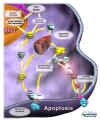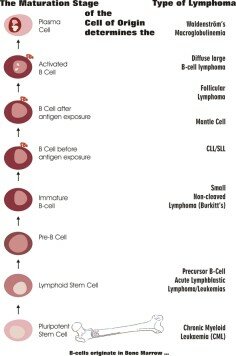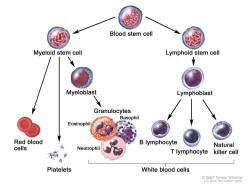|
About Lymphoma > Biology & Immunity
Last update: 01/02/2014
|
|
TOPICS
Antibodies | Apoptosis | B-cell Maturation | Blood | CD Antigens | Cells |
Growth Factors & Cytokines | Immune System | Microenvironment | NK cells | T-cells
In the News - and new resources:
.gif) |
NCI: The Immune System - Cancer.gov
Your immune system is a bodywide network of cells, tissues, and organs that has evolved to defend you against "foreign" invasions.
|
|
Antibodies

Source: NIH Click to enlarge
|
Wikipedia.org: "Antibodies are Y-shaped proteins that are found in blood or other bodily fluids .... are used by the immune system to identify and neutralize foreign objects like bacteria and viruses."
|
Apoptosis
Programmed cell death as signaled by the nuclei in normally functioning cells when age or state of cell health and condition dictates.

Apoptosis illustrated
|
Apoptosis and necrosis are two major processes by which cells die. Apoptosis is the ordered disassembly of the cell from within.
It is a natural mechanism by which cells "commit suicide" when they have outlived their purpose, become defective, or have aged.
Apoptosis prevents cells from accumulating and forming tumors.
Analogy: Chances are you've seen a movie with apoptosis as part of the plot ... in almost any James Bond film. A fortress containing classified information is rigged for destruction by the owners if the security of the building is compromised. The process requiring a series of commands, which are relayed from one authorized person to another. This to prevent a programmed self-destruction by a careless mistake or a rouge individual.
The fail-safe system is carried out from within by specialists, and regulated by others. The trigger is not pulled until all the criteria is met: the security threat is real and it can't be corrected; the command has been given by authorized individuals and verified by others, and the actions carried out by specialized personnel.
The security breach starts a chain of events (a cascade); each player communicating to the other until the big red button is pushed and the building destroyed; the sensitive information within it evaporating.
Similarly, our cells are rigged for self destruction when they become old or defective. The main purpose is to protect the body against replication of defective cells (cancer); and to remove old cells.
The program for cellular self-destruction is called apoptosis, which is a type of quality control. The old or defective cells "take one for the team." That some cells die and other live on to replicate helps achieve a balance in the body. If individual cells just replicated and never died, our organs would never cease growing.
What happens in a cancer cell is that some parts of the cell machinery that carry out, signal for, or authorize apoptosis no longer function ... because of damage to genes that produce proteins that regulate or carry out these functions.
Many chemotherapy treatments are designed to exploit apoptosis ... by causing sufficient damage to the cells that force the issue, magnifying the urgency to self-destruct. Waking up the components in the cell that authorize apoptosis, such as the P53 gene.
One way the Rituxan might work is by changing the balance of signals in the cells it binds to to favor apoptosis. Shifting the balance to self destruct without causing damage. (Rituxan may also flag bound cells for destruction by effector cells, which is not dependent on apoptosis.)
Some investigational targeted agents are designed to wake up or silence parts of the cell that carry out or block apoptosis. ...
Imagine that a key protein within the cell is overactive and is giving a STOP order. Then imagine a small molecule drug that fits the shape of this protein, stopping the STOP order. This class of drugs target inhibitors of apoptosis. (Note: If normal cells utilize the same or similar proteins to carry our normal cellular functions, you may have side effects.
So having an understanding of the control of apoptosis in normal and malignant cells will help to improve the diagnosis and treatment of malignancies. The goal of many treatments, including chemotherapies is to induce malignant cells to undergo apoptosis.
~ KarlS
-
Regulation of Apoptosis in Normal and Malignant Cell bloodjournal
-
Apoptosis - overview NIH
-
Apoptosis - mechanisms and discussion users.rcn.com/jkimball.ma
-
Apoptosis kimball.mal
"For every cell, there is a time to live and a time to die. "
A second way that cells die is called lysis, a more destructive mechanism in which cell membranes rupture and lose cytoplasm.
|
B-cell
stages of maturation

click image to enlarge
|
Wikipedia.org: "B cells are lymphocytes that play a large role in the humoral immune response as opposed to the cell-mediated immune response that is governed by T cells. B cells are produced in the bone marrow of most mammals and are therefore called B cells. The principal function of B cells is to make antibodies against soluble antigens. B cells are an essential component of the adaptive immune system."
B-cells have many stages of differentiation. The stage of the b-cell in which the cancer developed will determine the type of lymphoma, and potentially, targets for treatment.
.gif) |
Technical: The Pre-B Cell Receptor and Its Function during B Cell Development http://www.cmi.ustc.edu.cn/1/2/89.pdf
|
.gif) |
Technical: B lymphocytes: how they develop and function http://bit.ly/5PN6kj
|
.gif) |
B Cell - British Society for Immunology (link not available)
"Within the bone marrow, B cells are regulated in their development, and can be deleted when surface Ig receptors are cross-linked. This leads to cell death, but once B cells reach the spleen and enter the periarterial lymphoid sheath (PALS) some fine tuning through the antigen receptor can occur. Under the right circumstances these B cells will enter germinal centres where they can proliferate and interact with follicular dendritic cells and other cells. At each step along the way the B cell can be triggered via their antigen receptors either to die, or to enter the follicle and be protected against cell death. Hence, a number of signaling pathways must exist to regulate these crucial physiological processes."
|
.gif) |
Immunology immuno.path.cam.ac.uk
|
.gif) |
Interactive Animation of B Cell Maturation bio.davidson.edu
|
.gif) |
B Cell Generation, Activation & Differentiation users.ipfw.edu/ PDF
|
.gif) |
Lymphocyte Traffic Patterns Dr. Anderson
|
.gif) |
Technical: Immunoglobulins http://www.cehs.siu.edu/fix/medmicro/igs.htm
|
.gif) |
|
B-cell activation

|
Blood &
Basic Systems
|
Basic information about blood. Lymphoma is a cancer that affects a type of blood cell, called a lymphocyte.
.gif) |
About Blood users.rcn.com
|
.gif) |
Your blood and bone marrow cancerhelp.org
|

http://www.nlm.nih.gov/medlineplus/ency/article/003344.htm
|
CD-antigens
|
As lymphocytes mature, they express different protein receptors on the cell surface, which can aid in determining the type and maturation stage of the cells being examined. Some of these receptors, such as cd20, can be used as treatment targets (Rituxan). These proteins or antigen markers are called Clusters of Differentiation (CD).
.gif) |
Antigen markers on mature lymphocyte populations (illustrated)
|
.gif) |
Table of CD antigens NIH.gov
|
.gif) |
What CD markers are typical for my type of NHL NHL CyberFamily
|
|
Cells
|
Resources on normal cell biology
.gif) |
Cell biology tutorial biology-online.org
|
.gif) |
About cell membranes wikipedia
|
|
Growth factors
& cytokines
Understanding the
Immune System - NCI
|
Cells interact and coordinate activities by sending and receiving chemical signals.
.gif) |
Cytokine deregulation in cancer Biomed Pharmacother.
2001 Nov;55(9-10):543-7. PMID: 11769963 PubMed
|
.gif) |
Growth factors and cytokines, tables Medical Biochemistry
|
.gif) |
Hormones, table of rcn.com
|
.gif) |
IL-10 and NHL MDACC
|
|
Immune system
|
Lymphoma is a type of cancer that affects blood cells that are a part of the immune system, called lymphocytes.
.gif) |
NCI: The Immune System - Cancer.gov
|
.gif) |
Animation: Immunology in the Gut Mucosa : Nature Immunology http://bit.ly/UrrqOy
|
.gif) |
Immune system overview NIH.gov
|
.gif) |
Understanding Cancer Series: The Immune System  cancer.gov cancer.gov
Clear and comprehensive; organized by topics
|
.gif) |
Immune system for kids (and adults) kidshealth.org
Very nice primer for anyone; includes pronunciations of terms
|
.gif) |
About rheumb.bham.ac.uk | Dept of Microbiology |
Hartford.edu | omsusa.org | theBody.com | med.sc.edu
|
.gif) |
Introduction to Immunology Tutorial ~ Innate vs. Adaptive Immunity arizona.edu
|
.gif) |
Autoimmunity and Autoimmune Disease Johns Hopkins
|
.gif) |
Cell-Mediated Immunity: med.sc.edu
Cell interactions in specific immune responses
|
.gif) |
Immune Response System cehs.siu.edu
|
.gif) |
Immune System overview with illustrations Goldman, Prabhakar
|
.gif) |
Immunology And Immune System Disorders mfi.ku.dk
|
.gif) |
A Brief Guide to the Immunology of Peripheral Tolerance molbiol.ox.ac.uk
|
.gif) |
Kimball's Biology Pages users.rcn.com
Excellent resource for immunity and all manner of biological processes
|
.gif) |
ncbi.nlm.nih.gov
|
|
Microenvironment
|
B-cells (normal and malignant) do not live alone or behave in a vacuum. They are induced to grow or become dormant by signals in the host environment (microenvironment). For example, b-cell tumors may be prompted to grow by external stimuli, such as antigens or growth factors. There is evidence that surrounding cells are required to sustain or "nurse" the growth of some lymphomas.
.gif) |
Chronic B cell malignancies and bone marrow microenvironment.
Semin Cancer Biol. 2002 Apr;12(2):149-155. PMID: 12027587 PubMed
|
.gif) |
Tumor cell dissemination in follicular lymphoma. Blood. 2002 Mar 15;99(6):2192-8. PMID: 11877297 PubMed
|
.gif) |
Relative distribution of tumour cells and reactive cells in follicular lymphoma. J Pathol. 2001 Apr;193(4):498-504. PMID: 11276009 PubMed
|
|
NK-cells
|
NK -cells are already specialized to kill certain types of target cells, especially cells that have become infected with virus or have become cancerous.
.gif) |
About users.rcn.com/jkimball.ma.ultranet
|
|
T-cells
|
T-cells (T - from thymus) are part of our immune defense. We may be able to recruit this arm of our immune system to identify and attack malignant b-cells.
.gif) |
About wikipedia | sciencedaily
|
.gif) |
Cytotoxic T Lymphocytes (CTL) users.rcn.com/jkimball.ma
|
|